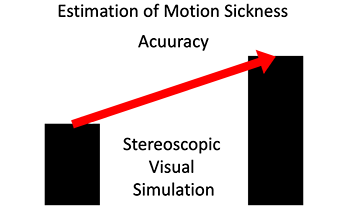References
1
2KoopmanP.WagnerM.2017Autonomous vehicle safety: an interdisciplinary challengeIEEE Intell. Transp. Syst. Mag.9909690–610.1109/MITS.2016.2583491
3RolnickA.LubowR. E.1991Why is the driver rarely motion sick? The role of controllability in motion sicknessErgon.34867879867–7910.1080/00140139108964831
4DielsC.BosJ. E.2016Self-driving carsicknessAppl. Ergon.53374382374–8210.1016/j.apergo.2015.09.009
5JicolC.WanC. H.DolingB.IllingworthC. H.YoonJ.HeadeyC.LutterothC.ProulxM. J.PetriniK.NeillE. O.2021Effects of emotion and agency on presence in virtual realityConf. on Human Factors in Computing Systems - Proc.1131–13ACMNew York City, NY10.1145/3411764.3445588
6WeechS.KennyS.Barnett-CowanM.2019Presence and cybersickness in virtual reality are negatively related: A reviewFrontiers in Psychology1015810.3389/fpsyg.2019.00158
7McCauleyM. E.SharkeyT. J.1992Cybersickness: Perception of self-motion in virtual environmentsPresence: Teleoperators and Virtual Environments1311318311–810.1162/pres.1992.1.3.311
8Jr.L. J.2000A discussion of cybersickness in virtual environmentsACM SIGCHI Bull.32475647–5610.1145/333329.333344
9ReasonJ. T.BrandJ. J.Motion Sickness1975Academic PressNew York
10NgA. K. T.ChanL. K. Y.LauH. Y. K.2020A study of cybersickness and sensory conflict theory using a motion-coupled virtual reality systemDisplays6110192210.1016/j.displa.2019.08.004
11IshakS.BubkaA.BonatoF.2018Visual occlusion decreases motion sickness in a flight simulatorPerception47521530521–3010.1177/0301006618761336
12McGillM.NgA.BrewsterS.2017I am the passenger: How visual motion cues can influence sickness for in-car VRConf. on Human Factors in Computing Systems - Proc.565556685655–68ACMNew York City, NY10.1145/3025453.3026046
13KimY. Y.KimH. J.KimE. N.KoH. D.KimH. T.2005Characteristic changes in the physiological components of cybersicknessPsychophysiology42616625616–2510.1111/j.1469-8986.2005.00349.x
14MinB. C.ChungS. C.MinY. K.SakamotoK.2004Psychophysiological evaluation of simulator sickness evoked by a graphic simulatorAppl. Ergon.35549556549–5610.1016/J.APERGO.2004.06.002
15LiuR.PeliE.HwangA. D.2017Measuring visually induced motion sickness using wearable devicesProc. IS&T Electronic Imaging: Human Vision and Electronic Imaging218223218–23IS&TSpringfield, VA10.2352/ISSN.2470-1173.2017.14.HVEI-147
16LiX.ZhuC.XuC.ZhuJ.LiY.WuS.2020VR motion sickness recognition by using EEG rhythm energy ratio based on wavelet packet transformComput. Methods Programs Biomed.18810526610.1016/j.cmpb.2019.105266
17LiY.LiuA.DingL.2019Machine learning assessment of visually induced motion sickness levels based on multiple biosignalsBiomed. Signal Process. Control49202211202–1110.1016/j.bspc.2018.12.007
18RecentiM.RicciardiC.AubonnetR.PiconeI.JacobD.SvanssonH. Á. R.AgnarsdóttirS.KarlssonG. H.BaeringsdóttirV.PetersenH.GargiuloP.2021Toward predicting motion sickness using virtual reality and a moving platform assessing brain, muscles, and heart signalsFrontiers in Bioengineering and Biotechnology913210.3389/fbioe.2021.635661
19VepakommaP.DeD.DasS. K.BhansaliS.2015A-Wristocracy: Deep learning on wrist-worn sensing for recognition of user complex activities2015 IEEE 12th Int’l. Conf. on Wearable and Implantable Body Sensor Networks, BSNIEEEPiscataway, NJ10.1109/BSN.2015.7299406
20RonaoC. A.ChoS. B.2016Human activity recognition with smartphone sensors using deep learning neural networksExpert Syst. Appl.59235244235–4410.1016/j.eswa.2016.04.032
21BanchiY.TsuchiyaK.HiroseM.TakahashiR.YamashitaR.KawaiT.2022Evaluation and estimation of discomfort during continuous work with mixed reality systems by deep learningProc. IS&T Electronic Imaging: Stereoscopic Displays and Applications309-1309-4309-1–4IS&TSpringfield, VA10.2352/EI.2022.34.2.SDA-309
22HäkkinenJ.OhtaF.KawaiT.2018Time course of sickness symptoms with HMD viewing of 360-degree videosJ. Imaging Sci. Technol.60403-160403-1160403-1–60403-1110.2352/J.ImagingSci.Technol.2018.62.6.060403
23LinC.-T.TsaiS.-F.KoL.-W.2013EEG-based learning system for online motion sickness level estimation in a dynamic vehicle environmentIEEE Trans. Neural Netw. Learning Systems24168917001689–70010.1109/TNNLS.2013.2275003
24LeeT. M.YoonJ.-C.LeeI.-K.2019Motion sickness prediction in stereoscopic videos using 3D convolutional neural networksIEEE Trans. Vis. Comput. Graphics25191919271919–2710.1109/TVCG.2019.2899186
25KennedyR. S.LaneN. E.BerbaumK. S.LilienthalM. G.1993Simulator sickness questionnaire: An enhanced method for quantifying simulator sicknessInt. J. Aviation Psychology3203220203–2010.1207/s15327108ijap0303˙3
26WangY.ChardonnetJ.-R.MerienneF.2019VR sickness prediction for navigation in immersive virtual environments using a deep long short term memory model2019 IEEE Conf. on Virtual Reality and 3D User Interfaces (VR)187418811874–81IEEEPiscataway, NJ10.1109/VR.2019.8798213

 Find this author on Google Scholar
Find this author on Google Scholar Find this author on PubMed
Find this author on PubMed